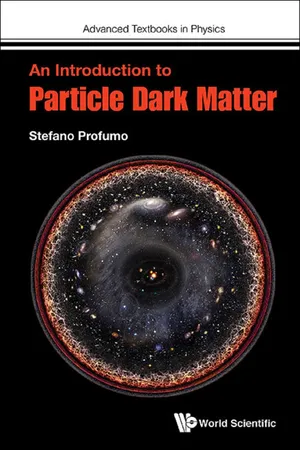
- 288 pages
- English
- ePUB (mobile friendly)
- Available on iOS & Android
An Introduction to Particle Dark Matter
About this book
-->
What is the dark matter that fills the Universe and binds together galaxies? How was it produced? What are its interactions and particle properties?
The paradigm of dark matter is one of the key developments at the interface of cosmology and elementary particle physics. It is also one of the foundations of the standard cosmological model. This book presents the state of the art in building and testing particle models for dark matter. Each chapter gives an analysis of questions, research directions, and methods within the field. More than 200 problems are included to challenge and stimulate the reader's knowledge and provide guidance in the practical implementation of the numerous "tools of the trade" presented. Appendices summarize the basics of cosmology and particle physics needed for any quantitative understanding of particle models for dark matter.
This interdisciplinary textbook is essential reading for anyone interested in the microscopic nature of dark matter as it manifests itself in particle physics experiments, cosmological observations, and high-energy astrophysical phenomena: from graduate students and advanced undergraduates to cosmologists and astrophysicists interested in particle models for dark matter and particle physicists interested in early-universe cosmology and high-energy astrophysics.
-->
Request Inspection Copy
-->
Frequently asked questions
- Essential is ideal for learners and professionals who enjoy exploring a wide range of subjects. Access the Essential Library with 800,000+ trusted titles and best-sellers across business, personal growth, and the humanities. Includes unlimited reading time and Standard Read Aloud voice.
- Complete: Perfect for advanced learners and researchers needing full, unrestricted access. Unlock 1.4M+ books across hundreds of subjects, including academic and specialized titles. The Complete Plan also includes advanced features like Premium Read Aloud and Research Assistant.
Please note we cannot support devices running on iOS 13 and Android 7 or earlier. Learn more about using the app.
Information
Chapter 1
Particle Dark Matter: The Name of the Game
1.1Praeludium
1.2There is more matter than the matter that shines — classical (mechanical) evidences
Zwicky and the virial theorem











Table of contents
- Cover
- Halftitle
- Series Editors
- Title
- Copyright
- Preface
- About the Author
- Acknowledgments
- Contents
- Chapter 1. Particle Dark Matter: The Name of the Game
- Chapter 2. The Thermal Relic Paradigm: Zeroth-Order Lessons from Cosmology
- Chapter 3. The Thermal Relic Paradigm: A Closer Look
- Chapter 4. The Art of WIMP Direct Detection
- Chapter 5. Indirect Dark Matter Searches
- Chapter 6. Searching for Dark Matter with Particle Colliders
- Chapter 7. Axions and Axion-like Particles as Dark Matter
- Chapter 8. Sterile Neutrinos as Dark Matter Particles
- Chapter 9. Bestiarium: A Short, Biased Compendium of Notable Dark Matter Particle Candidates and Models
- Appendix A. Rudimentary Particle Physics
- Appendix B. Rudimentary Cosmology
- Bibliography
- Index